Connecting APIs with Zapier webhooks is a straightforward way to automate your workflows. You can set up triggers that listen for specific app events, then send or receive data via secure webhook URLs. By configuring the right API requests and managing authentication, you guarantee smooth data transfer and real-time updates. To keep everything running securely and efficiently, you’ll want to follow best practices for setup and troubleshooting—more details will guide you through each step.
Key Takeaways
- Set up Zapier webhooks by choosing trigger events and configuring custom webhook URLs for API integration.
- Secure data transfer with SSL/TLS encryption and authentication methods like API keys or OAuth.
- Use correct HTTP methods and payload formats to ensure accurate API requests via webhooks.
- Monitor response codes and implement retries to handle API rate limits and errors effectively.
- Regularly test and update webhook endpoints to maintain security, reliability, and seamless API connectivity.
Understanding Zapier Webhooks and Their Functionality
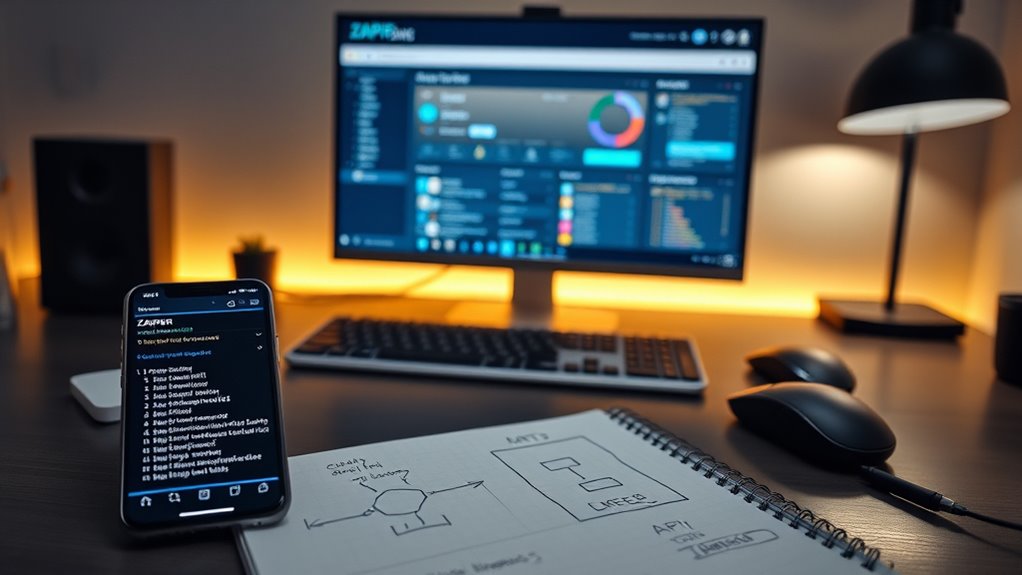
Have you ever wondered how to connect different apps seamlessly without complex coding? That’s where Zapier Webhooks come in. They act as bridges, allowing apps to communicate instantly by sending real-time data. When using webhooks, Webhook security is vital—make sure your data stays protected with authentication measures. Also, keep API rate limiting in mind; excessive webhook activity can overwhelm your apps or cause delays. Zapier manages these limits, so your integrations run smoothly without hitting restrictions. By understanding how Zapier Webhooks function, you can automate workflows efficiently and securely. They’re flexible, allowing you to trigger actions across apps with minimal setup. This foundation helps you build reliable, secure integrations that streamline your tasks without needing complex coding skills. Additionally, understanding the importance of monitoring webhook activity ensures your automation remains reliable over time.
Setting Up Your Zapier Account for Webhook Integration
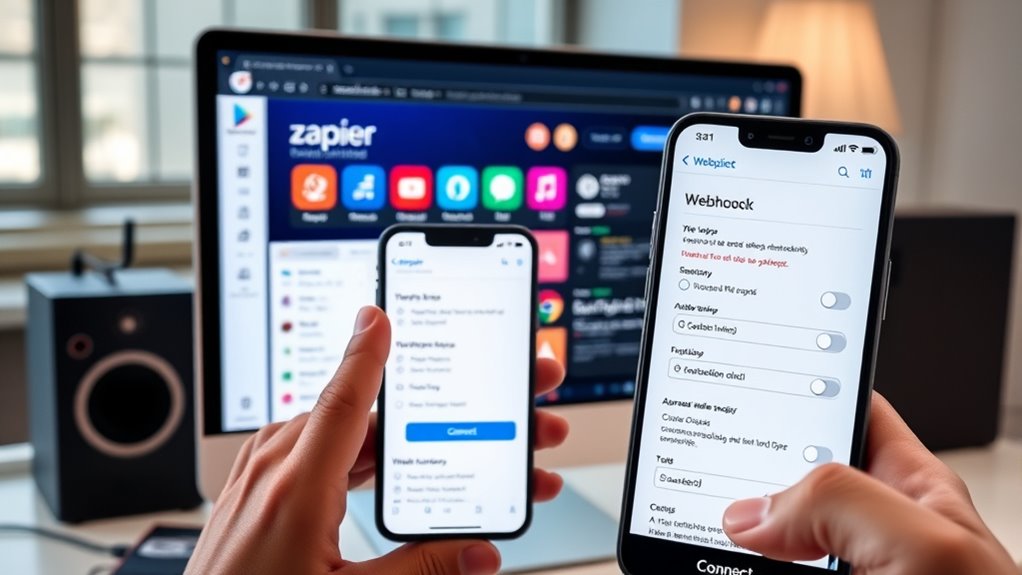
Getting started with webhook integration in Zapier requires setting up your account properly. First, guarantee your account has the necessary permissions to handle API security measures, protecting your data during transfers. Verify your account settings to enable webhook features and manage access controls. To minimize webhook latency, optimize your Zapier workflows by keeping trigger and action configurations efficient. Use secure authentication methods like API keys or OAuth to safeguard your integrations. Regularly review your account activity for unusual access, maintaining robust API security. Additionally, test your webhook endpoints to confirm quick response times, reducing delays and ensuring smooth data flow. Proper setup now lays a strong foundation for reliable, secure, and fast webhook integrations in your Zapier workflows. Incorporating projector calibration techniques can further enhance the accuracy and reliability of your data exchanges.
Creating a New Zap: Choosing the Trigger and Action Events
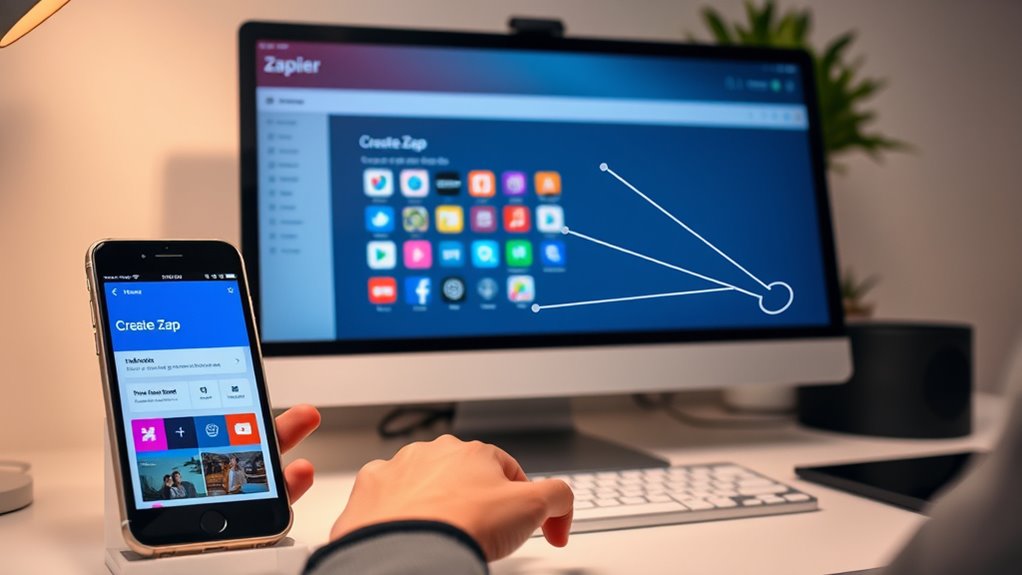
When creating a new Zap, your first step is to select the Trigger Event that will start the automation. Next, choose the Action Event, which defines what happens after the trigger occurs. Picking the right options guarantees your workflow runs smoothly and efficiently. Incorporating industry trends into your choices can also help optimize your automation process.
Selecting Trigger Event
Choosing the right trigger event is essential because it determines when your Zap will start running. Your event selection impacts how smoothly your automation functions. To make the best choice, consider the different trigger options available and how they align with your goals. Keep in mind that some trigger options capture specific actions, while others monitor broader changes. Here are some key points to guide your decision:
- Understand the types of trigger options for your app
- Match trigger events to your desired workflow
- Check if the trigger supports real-time data
- Evaluate if multiple trigger options are available
- Test the trigger event to guarantee accuracy
- Be aware of narcissistic behaviors that might influence how your automation interacts with user inputs or data patterns.
Choosing Action Event
Selecting the right action event is essential because it determines what your automation will do once triggered. When choosing an action, consider how it will interact with your API, guaranteeing it aligns with your API security protocols. This helps prevent unauthorized access and keeps your data safe. Additionally, webhook customization plays a key role here; you can define how data is sent and processed, tailoring responses to your needs. Make sure the action event supports the necessary API endpoints and functions. By carefully selecting an action event, you streamline your workflow, improve security, and optimize webhook integration. It’s also important to understand emotional support principles to ensure your automation process remains resilient and adaptable to unexpected issues. This step ensures your Zap performs precisely as intended, facilitating smooth communication between your app and the API without risking security breaches.
Configuring Webhook URLs for Sending and Receiving Data
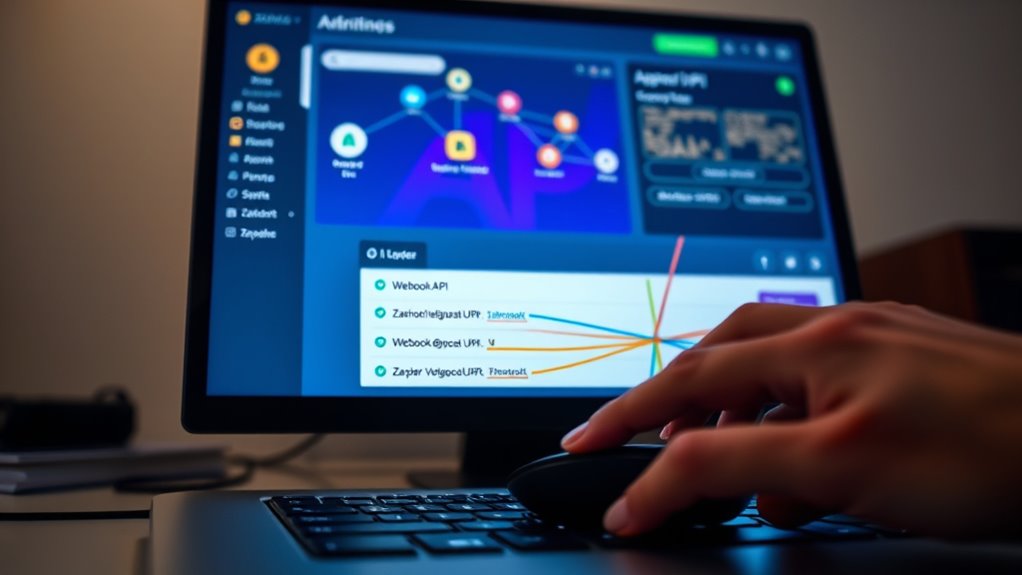
Configuring webhook URLs is a crucial step in enabling seamless data exchange between your apps via Zapier. You need to set up URLs that correctly handle incoming and outgoing data, ensuring smooth integration. Pay attention to webhook security by using HTTPS and authentication methods to prevent unauthorized access. Proper data validation is essential to verify incoming data, avoiding errors and security issues. Here are key points to take into account:
- Use unique, descriptive webhook URLs for clarity
- Implement SSL/TLS for secure data transmission
- Set up validation rules to verify incoming data
- Configure response handling to confirm successful data receipt
- Regularly test and update webhook URLs for security and efficiency
Following these practices guarantees safe, reliable data flow between your apps.
Connecting External APIs Using Webhook Requests

To connect external APIs with webhook requests, you need to set up the proper webhook calls to communicate effectively. Managing API authentication guarantees your data stays secure and only authorized services access it. Once you configure these elements correctly, automating integrations becomes much smoother. Incorporating security best practices such as encryption techniques can further protect your data during transmission.
Setting Up Webhook Calls
Setting up webhook calls is a straightforward way to connect external APIs with your Zapier workflows. To guarantee smooth integration, keep Webhook security in mind by verifying payloads and securing endpoints. Be aware of API rate limits to avoid disruptions or blocked requests. When configuring your webhook, consider these key steps:
- Choose the correct HTTP method (POST, GET, etc.)
- Set appropriate headers and payload data
- Test the webhook with sample data
- Monitor response status codes for errors
- Implement retries for failed requests
- Incorporate security best practices to protect your data and endpoints.
Managing API Authentication
Once you’ve established your webhook call, the next step is to handle API authentication to guarantee secure and authorized data exchange. Many APIs require authentication via API keys, OAuth tokens, or other methods. Managing OAuth tokens is essential, as they often expire and need refreshing to maintain access. Be aware of API rate limits, which restrict the number of requests you can make within a specific timeframe; exceeding these limits can lead to temporary blocks or errors. To avoid disruptions, implement proper token management strategies, such as automatic refreshes, and monitor your API usage regularly. Proper token management is crucial for maintaining seamless integration and avoiding service interruptions. Ensuring correct authentication not only secures your data but also prevents issues related to rate limits, keeping your Zapier workflows running smoothly and reliably.
Testing Your Webhook Workflow to Ensure Proper Data Transfer
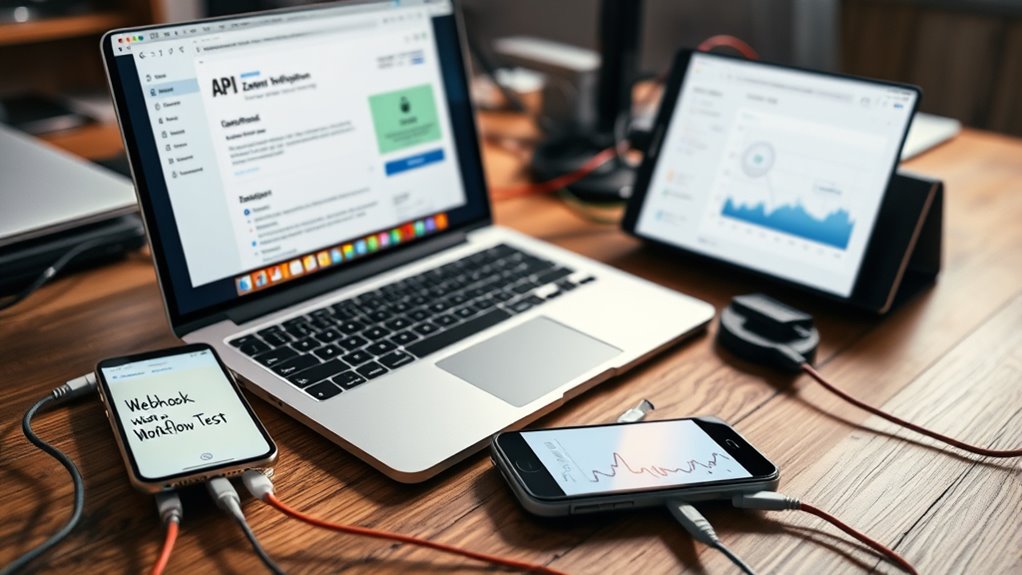
Before deploying your webhook workflow, it’s vital to verify it thoroughly to ensure data transfers correctly. Testing helps you confirm data validation processes work smoothly and error handling responds appropriately. To do this effectively, consider these steps:
Thorough testing ensures your webhook transfers data accurately and handles errors effectively.
- Send test payloads to verify data accuracy
- Check for consistent data formatting
- Monitor webhook response codes for errors
- Validate that error handling triggers correctly
- Review logs for unexpected issues
- Incorporate feedback from internal company hackathons to identify potential vulnerabilities
Performing these tests guarantees your data moves seamlessly between apps and that errors are managed efficiently. Proper testing not only ensures smooth operation but also saves time troubleshooting later. Keep an eye on data validation and error handling to maintain reliable workflows and avoid data loss or mismatches. This step is vital for a robust, error-free integration.
Automating Data Synchronization Between Applications
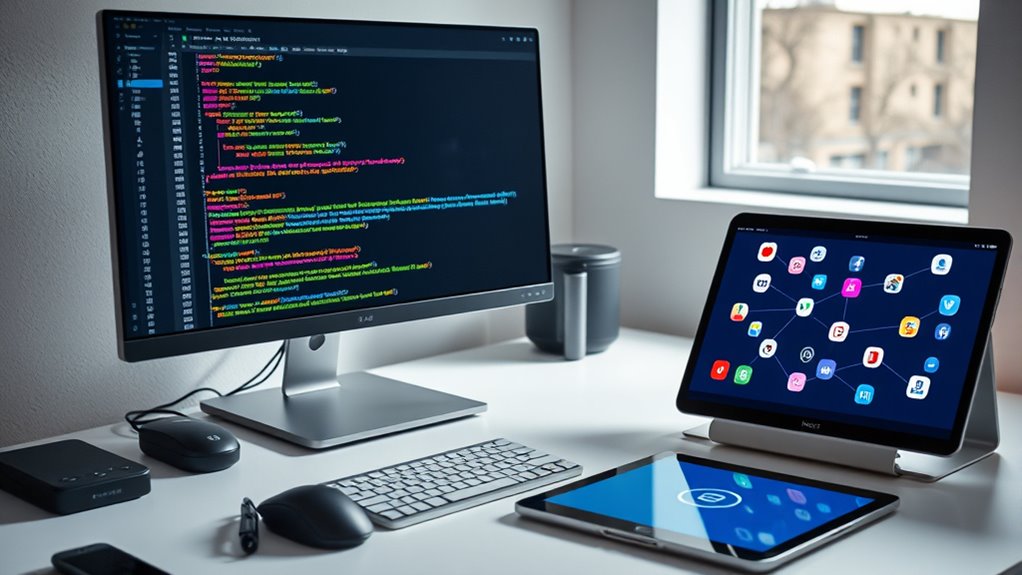
Automating data synchronization between applications streamlines your workflows by guaranteeing that information stays up-to-date across platforms without manual intervention. When setting up Zapier webhooks, focus on maintaining API security to prevent unauthorized access and protect sensitive data. Using secure authentication methods, such as API keys or OAuth, helps keep data private during transfers. Regularly review your webhook configurations to avoid data leaks and ensure compliance with privacy standards. By automating updates, you reduce errors caused by manual entry and improve overall efficiency. Remember, safeguarding data privacy isn’t just about technology—it’s about implementing best practices and monitoring your integrations continuously. Additionally, understanding Jeep Tuning concepts can help tailor your setups for specific vehicle modifications, ensuring compatibility and optimal performance. This approach guarantees that your synchronized data remains accurate, secure, and compliant across all connected applications.
Troubleshooting Common Webhook Integration Issues

Even with well-implemented webhooks, technical issues can still occur, disrupting your data flows and causing confusion. To troubleshoot effectively, focus on common problems like webhook security vulnerabilities, which may lead to unauthorized access or data breaches. Check if API rate limiting is causing missed or delayed webhook deliveries, especially during high traffic. Ensure your webhook URLs are correct and responsive, as server downtime can halt data transfer. Verify that your webhook payloads adhere to the expected format, preventing parsing errors. Additionally, monitor logs for errors or retries and confirm that your webhook setup complies with security best practices to avoid disruptions. Addressing these issues promptly helps maintain a smooth, secure integration. Reviewing webhook documentation can provide additional guidance on best practices and troubleshooting steps.
Best Practices for Managing and Securing Your Webhook Connections

To effectively manage and secure your webhook connections, you need to implement best practices that safeguard your data and ensure reliable communication. Prioritize webhook security by using HTTPS to encrypt data and prevent eavesdropping. Always verify the source of incoming requests through API authentication methods like tokens or signatures to confirm legitimacy. Limit webhook access to trusted IP addresses and rotate authentication credentials regularly to minimize risks. Keep your webhook endpoints private and avoid exposing them publicly. Monitor activity logs for unusual behavior that could indicate security breaches. Additionally, understanding floating on water can inspire creative ways to visualize seamless and smooth data flows in your integrations. By applying these practices, you protect sensitive information, maintain trust, and ensure your integrations function smoothly. Securing your webhook connections is essential for reliable, safe API communication in your automation workflows.
Frequently Asked Questions
Can I Connect Multiple APIS With a Single Zap Webhook?
You can connect multiple APIs with a single Zap webhook by using API orchestration and webhook chaining. This setup allows you to trigger a primary webhook that then calls other APIs sequentially or conditionally. By designing your Zap creatively, you can orchestrate complex workflows, ensuring data flows smoothly between APIs. Just remember, effective API orchestration and webhook chaining require careful planning to avoid delays or errors in your automation process.
How Do I Handle API Authentication via Webhooks?
Think of API authentication like a secret handshake at a fancy club. When using webhooks, you handle it by including API tokenization in your request headers or leveraging OAuth integration for secure access. This way, Zapier can verify seamlessly without exposing sensitive info. Just like keys to a vault, these methods ensure your data stays protected while automating your workflows efficiently.
What Are the Limitations of Zapier Webhook Data Payloads?
When working with Zapier webhooks, you might find limitations with payload size and data format. Zapier typically handles payloads up to 100 KB, so larger data might get truncated or fail to send. Also, it prefers JSON or form data formats; unsupported formats could cause issues. To avoid problems, keep payloads concise and use compatible data formats, ensuring smooth data transfer and reliable automation.
Is Real-Time API Data Syncing Possible With Zapier Webhooks?
Did you know that 80% of users seek real-time data updates? With Zapier webhooks, you can achieve near real-time API data syncing, but it depends on API latency and webhook reliability. If the API responds quickly and webhooks are consistently delivered, you’ll experience minimal delays. However, network issues or slow API responses can introduce latency, so ensuring your setup is optimized is key for effective real-time data syncing.
How Do I Secure Webhook URLS From Unauthorized Access?
To safeguard webhook URLs from unauthorized access, you should implement encryption protocols like HTTPS to protect data in transit. Additionally, use IP whitelisting to restrict access only to trusted IP addresses. These measures guarantee that only authorized systems can send or receive data through your webhooks, minimizing security risks. Regularly monitor and update your security settings to maintain a robust defense against potential threats.
Conclusion
Think of your webhooks as the bridges connecting your digital worlds, carrying essential data like messages in a bottle across vast seas. When crafted with care and security, these connections become reliable pathways, guiding your workflows smoothly. Remember, each successful transfer is a lighthouse shining in the fog of complexity. By mastering these links, you illuminate your automation journey, transforming chaos into clarity—your seamless integration voyage begins now.









